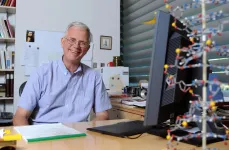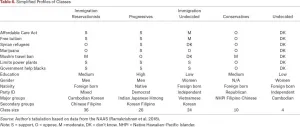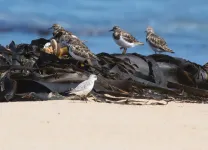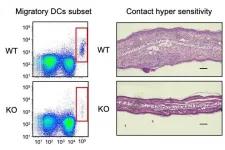(Press-News.org) The aurora borealis, or northern lights, that fill the sky in high-latitude regions have fascinated people for thousands of years. But how they're created, while theorized, had not been conclusively proven.
In a new study, a team of physicists led by University of Iowa reports definitive evidence that the most brilliant auroras are produced by powerful electromagnetic waves during geomagnetic storms. The phenomena, known as Alfven waves, accelerate electrons toward Earth, causing the particles to produce the familiar atmospheric light show.
The study, published online June 7 in the journal Nature Communications, concludes a decades-long quest to demonstrate experimentally the physical mechanisms for the acceleration of electrons by Alfven waves under conditions corresponding to Earth's auroral magnetosphere.
"Measurements revealed this small population of electrons undergoes 'resonant acceleration' by the Alfven wave's electric field, similar to a surfer catching a wave and being continually accelerated as the surfer moves along with the wave," says Greg Howes, associate professor in the Department of Physics and Astronomy at Iowa and study co-author.
Scientists have known that energized particles that emanate from the sun--such as electrons racing at approximately 45 million miles per hour--precipitate along the Earth's magnetic field lines into the upper atmosphere, where they collide with oxygen and nitrogen molecules, kicking them into an excited state. These excited molecules relax by emitting light, producing the colorful hues of the aurora.
The theory was supported by spacecraft missions that frequently found Alfven waves traveling Earthward above auroras, presumably accelerating electrons along the way. Although space-based measurements had supported the theory, limitations inherent to spacecraft and rocket measurements had prevented a definitive test.
The physicists were able to find confirmatory evidence in a series of experiments conducted at the Large Plasma Device (LPD) in UCLA's Basic Plasma Science Facility, a national collaborative research facility supported jointly by the U.S. Department of Energy and National Science Foundation.
"The idea that these waves can energize the electrons that create the aurora goes back more than four decades, but this is the first time we've been able to confirm definitively that it works," says Craig Kletzing, professor in the Department of Physics and Astronomy at Iowa and a study co-author. "These experiments let us make the key measurements that show that the space measurements and theory do, indeed, explain a major way in which the aurora are created."
The phenomenon of electrons "surfing" on the electric field of a wave is a theoretical process known as Landau damping, first proposed by Russian physicist Lev Landau in 1946. Through numerical simulations and mathematical modeling, the researchers demonstrated that the results of their experiment agreed with the predicted signature for Landau damping.
The agreement of experiment, simulation, and modeling provides the first direct evidence that Alfven waves can produce accelerated electrons, causing the aurora, says Troy Carter, professor of physics at UCLA and director of the UCLA Plasma Science and Technology Institute.
"This challenging experiment required a measurement of the very small population of electrons moving down the LPD chamber at nearly the same speed as the Alfven waves, numbering less than one in a thousand of the electrons in the plasma," Carter says.
INFORMATION:
James Schroeder, assistant professor of physics at Wheaton College and the study's corresponding author, earned a doctorate at Iowa. Frederick Skiff, professor in the UI Department of Physics and Astronomy, is a study co-author. Stephen Vincena and Seth Dorfman, with UCLA's Space Science Institute, are contributing authors.
More detailed information is available at: https://homepage.physics.uiowa.edu/~ghowes/research/aurora.html.
The U.S. National Science Foundation, the U.S. Department of Energy, and NASA funded the research.
What The Study Did: In this study, short-term effectiveness of the first dose of the BNT162b2 (BioNTech/Pfizer) vaccine against SARS-CoV-2 infection 13 to 24 days after immunization in a real-world setting was assessed.
Authors: Gabriel Chodick, Ph.D., of the Maccabi Institute for Research & Innovation, Maccabi Healthcare Services, in Tel Aviv, Israel, is the corresponding author.
To access the embargoed study: Visit our For The Media website at this link https://media.jamanetwork.com/
(doi:10.1001/jamanetworkopen.2021.15985)
Editor's Note: Please see the article for additional information, including other authors, author contributions and affiliations, ...
What The Study Did: Among children with a COVID-19 diagnosis, researchers in this study examined what other conditions are common and which are associated with severe COVID-19 illness.
Authors: Lyudmyla Kompaniyets, Ph.D., of the U.S. Centers for Disease Control and Prevention in Atlanta, is the corresponding author.
To access the embargoed study: Visit our For The Media website at this link https://media.jamanetwork.com/
(doi:10.1001/jamanetworkopen.2021.11182)
Editor's Note: Please see the article for additional information, including other authors, author contributions and affiliations, conflict of interest and financial disclosures, ...
What The Study Did: Researchers analyzed conversations on public Facebook groups to explore automated misinformation.
Authors: John W. Ayers, Ph.D., M.A., of the University of California, San Diego, in LaJolla, is the corresponding author.
To access the embargoed study: Visit our For The Media website at this link https://media.jamanetwork.com/
(doi:10.1001/jamainternmed.2021.2498)
Editor's Note: The article includes conflict of interest and funding/support disclosures. Please see the article for additional information, including other authors, author contributions and affiliations, conflict of interest and financial ...
La Jolla, Calif. (June 07, 2021) -- "The coronavirus pandemic has sparked what the World Health Organization has called an 'infodemic' of misinformation," said Dr. John W. Ayers, a scientist who specializes in public health surveillance. "But, bots --like those used by Russian agents during the 2016 American presidential election-- have been overlooked as a source of COVID-19 misinformation."
A new study published in JAMA Internal Medicine led by Dr. Ayers, Co-Founder of the Center for Data Driven Health and Vice Chief of Innovation within the Division of Infectious Diseases ...
While DNA provides the genetic recipe book for biological form and function, it is the job of the body's proteins to carry out the complex commands dictated by DNA's genetic code.
Stuart Lindsay, a researcher at the Biodesign Institute at ASU, has been at the forefront of efforts to improve rapid DNA sequencing and has more recently applied his talents to explore the much thornier problem of sequencing protein molecules, one molecule at a time.
In a new overview article, Lindsay's efforts are described along with those of international colleagues, who are applying a variety of innovative strategies for protein sequencing at the single-cell, and even single-molecule ...
The recent attacks against Asian Americans have put Asians in the U.S. in the spotlight. Many of the victims are first-generation immigrants in ethnic communities, while those rallying for the victims are second-generation Asian Americans. A new Dartmouth study explores who Asian Americans are today and the range of identities this category encompasses.
The study, by END ...
An international coalition of eye researchers used machine learning to develop classification criteria for 25 of the most common types of uveitis, a collection of over 30 diseases characterized by inflammation inside the eye. Together, these diseases are the fifth leading cause of blindness in the United States. The Standardization of Uveitis Nomenclature (SUN) Working Group, funded by the National Eye Institute (NEI), published its classification criteria in the American Journal of Ophthalmology. NEI is part of the National Institutes of Health.
"In the past, clinical research in the field of uveitis has been hampered by the lack of widely-accepted ...
Lead is a toxic metal, and its widespread use has led to significant environmental pollution and public health problems in many parts of the world. This has led the WHO to include it on a list of ten chemicals that cause serious health problems. However, lead poisoning continues to affect many population groups. A study published today in open access in the journal Environment International found high levels of lead in indigenous people in Peruvian Amazonia living near areas where oil extraction takes place. The research was led by Cristina O'Callaghan-Gordo, a professor and researcher in Health Sciences Studies at the Universitat Oberta de Catalunya (UOC) and the Barcelona ...
As Australia officially enters winter, UniSA ecologists are urging coastal communities to embrace all that the season brings, including the sometimes-unwelcome deposits of brown seaweed that can accumulate on the southern shores.
While tidal seaweed (or sea wrack) may seem unsightly - especially at beach-side tourist destinations - new research from the University of South Australia shows that it plays a vital role for many migratory seabirds and should be protected.
In the first study of its kind, UniSA researchers show that beach-cast seaweed provides shelter, ...
Osaka, Japan - In a new study, researchers from Osaka University discovered a novel molecular mechanism by which immune cells migrate to fight off infections. These findings may help in understanding the development of certain immune deficiency disorders and establish novel therapies against them.
Immune cells represent a diverse group of cells. Some circulate in the blood stream and migrate to infected tissues after receiving signals from damaged tissues. Others reside in tissues to take up the invading microbe, migrate to lymph nodes and activate an immune response. Therefore, to function effectively, the immune system's activities ...






